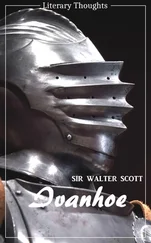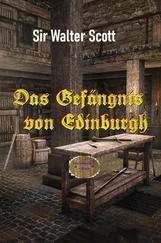Walter Scott - Ivanhoe
Здесь есть возможность читать онлайн «Walter Scott - Ivanhoe» — ознакомительный отрывок электронной книги совершенно бесплатно, а после прочтения отрывка купить полную версию. В некоторых случаях можно слушать аудио, скачать через торрент в формате fb2 и присутствует краткое содержание. Жанр: Исторические приключения, на английском языке. Описание произведения, (предисловие) а так же отзывы посетителей доступны на портале библиотеки ЛибКат.
- Название:Ivanhoe
- Автор:
- Жанр:
- Год:неизвестен
- ISBN:нет данных
- Рейтинг книги:4 / 5. Голосов: 1
-
Избранное:Добавить в избранное
- Отзывы:
-
Ваша оценка:
- 80
- 1
- 2
- 3
- 4
- 5
Ivanhoe: краткое содержание, описание и аннотация
Предлагаем к чтению аннотацию, описание, краткое содержание или предисловие (зависит от того, что написал сам автор книги «Ivanhoe»). Если вы не нашли необходимую информацию о книге — напишите в комментариях, мы постараемся отыскать её.
Ivanhoe — читать онлайн ознакомительный отрывок
Ниже представлен текст книги, разбитый по страницам. Система сохранения места последней прочитанной страницы, позволяет с удобством читать онлайн бесплатно книгу «Ivanhoe», без необходимости каждый раз заново искать на чём Вы остановились. Поставьте закладку, и сможете в любой момент перейти на страницу, на которой закончили чтение.
Интервал:
Закладка:
4 (p. 80) the host of the Pharoah: Isaac recalls the biblical account of the fate of Pharoah’s army at the crossing of the Red Sea in Exodus 14:25.
CHAPTER VII
1 (p. 83) epigraph: The lines are from John Dryden’s medievalist romance Palamon and Arcite; or, The Knight’s Tale (1699; 3.453—463).
2 (p. 92) Bride of the Canticles: Solomon is the ”wise king” whose Temple in Jerusalem Richard has failed to recapture. He is also the supposed author of the biblical Song of Songs, also known as the Canticle of Canticles, a set of poems famous for their lustrous evocation of female beauty.
3 (p. 94) William Rufus: William II of England went hunting in the New Forest in 1100 and never returned. He was shot, presumably by his companion Walter Tyrrell (who fled abroad), but whether by design or accident was never determined.
CHAPTER VIII
1 (p. 96) epigraph: The lines are from Dryden’s Palamon and Arcite (3.580-586).
2 (p. 99) The knights are dust … with the saints, we trust: [Author’s note] Lines from Coleridge. These lines are part of an unpublished poem by Coleridge, whose muse so often tantalises with fragments which indicate her powers, while the manner in which she flings them from her betrays her caprice, yet whose unfinished sketches display more talent than the laboured master-pieces of others.
3 (p. 104) the arrogance and wealth that finally occasioned their suppression: In the early fourteenth century, Rome turned against the Knights Templars, charging the order with immorality and heresy, though in reality taking aim at their wealth and power. The order’s demise was sealed by a papal bull in 1312, and by the burning of the Grand Master in 1314.
CHAPTER IX
1 (p. 107) epigraph: The source for these slightly altered lines—Dryden’s The Flower and the Leaf; or, The Lady in the Arbor: A Vision (1700; lines 175-177, 184—189)—is another poem in which Dryden, like Scott after him, revisits the Middle Ages.
2 (p. 112) Og the King of Bashan, and Sihon, King of the Amorites: In the biblical accounts (Numbers 21 and 32:33), these two Canaanite kings were killed in battle against the Israelites.
CHAPTER X
1 (p. 116) epigraph: The lines are from Christopher Marlowe’s The Jew of Malta (c.1592; act 2, scene 1).
CHAPTER XI
1 (p. 126) epigraph: The lines are from Shakespeare’s The Two Gentlemen of Verona (act 4, scene 1).
2 (p. 129) the stream… in the wilderness: See the Bible, Exodus 15:23-27 and 17:6.
CHAPTER XII
1 (p. 133) epigraph: The poetry, from Chaucer’s Canterbury Tales (lines 2599-2610), is taken from ”The Knight’s Tale,” the story of the battle between the knights Palamon and Arcite, from which Scott drew significant details for his account of the Ashby tournament.
CHAPTER XIII
1 (p. 144) epigraph: Misattributed to Homer’s Iliad, the passage nevertheless is strongly reminiscent of Pope’s translation and of the events of book 24, which describe the funeral games following the death of Patroclus. The actual source is a far more obscure eighteenth-century text, William Wilkie’s The Epigoniad 5.141-146.
2 (p. 145) attractions and antipathies: Pliny’s Natural History, an ancient text well known in the Middle Ages, explains specific natural phenomena, such as magnetic force, according to a principle of inherent attraction or antipathy between material objects.
3 (p. 146) myrrh … camphire: See the Bible, Song of Songs 1:13-14.
CHAPTER XIV
1 (p. 153) epigraph: The lines are from Thomas Warton’s ”Ode for the New Year, 1787” (lines 1-6).
2 (p. 159) a Saxon would have been held nidering: [Author’s note] Nidering. There was nothing accounted so ignominious among the Saxons as to merit this disgraceful epithet. Even William the Conqueror, hated as he was by them, continued to draw a considerable army of Anglo-Saxons to his standard by threatening to stigmatise those who staid at home as nidering. Bartholinus, I think, mentions a similar phrase which had like influence on the Danes.—L. T.
CHAPTER XV
1 (p. 162) epigraph: The lines are from Joanna Baillie’s Count Basil: A Tragedy (1798; act 2, scene 3). Scott, a great promoter of Bail-lie’s plays, once likened her to Shakespeare.
CHAPTER XVI
1 (p. 167) epigraph: The lines are from Thomas Parnell’s The Hermit (1729; lines 1-6).
2 . (p. 174) Shadrach … King of the Saracens: The king here is Nebuchadnezzar of Babylon; in the Bible, the brothers Shadrach, Meshach, and Abednego walk untouched through the fire in Daniel 3. The English came to apply the term “Saracen” to any Muslim rather than specifically to the tribes of the Arabian Peninsula, its original Greek designation.
3 (p. 177) scissors … scimitar of Goliath: In the biblical account, Delilah emasculates Samson by cutting off his hair while he slept (Judges 16:19); Jael nails a tent-peg through the head of Sisera, also sleeping (Judges 4:21); and Goliath’s scimitar fails to defend him from a slingshot to the head delivered by the boy David (1 Samuel 17:40-51).
4 (p. 178) make the harp-strings tinkle: [Author’s note] The Jolly Hermit. All readers, however slightly acquainted with black letter, must recognise in the clerk of Copmanhurst, Friar Tuck, the buxom confessor of Robin Hood’s gang, the curtal friar of Fountain’s Abbey.
CHAPTER XVII
1 (p. 178) epigraph: The lines, slightly altered, are from Thomas Warton’s “Inscription in a Hermitage at Ansley Hall in Warwickshire” (1777; lines 25—30).
2 (p. 179) a ballad in the vulgar English: [Author’s note] Minstrelsy. The realm of France, it is well known, was divided betwixt the Norman and Teutonic race, who spoke the language in which the word “yes” is pronounced as oui, and the inhabitants of the southern regions, whose speech, bearing some affinity to the Italian, pronounced the same word oc. The poets of the former race were called minstrels, and their poems lays; those of the latter were termed troubadours, and their compositions called sirventes and other names. Richard, a professed admirer of the joyous science in all its branches, could imitate either the minstrel or troubadour. It is less likely that he should have been able to compose or sing an English ballad; yet so much do we wish to assimilate him of the Lion Heart to the land of the warriors whom he led, that the anachronism, if there be one, may readily be forgiven.
3 (p. 180) Iconium’s turban’d soldan fell: Iconium is the medieval name for the Turkish city of Konya, which fell to the advancing Crusaders in 1190.
4 (p. 181) a sort of derry-down chorus: [Author’s note] Derry-down Chorus. It may be proper to remind the reader that the chorus of “derry-down” is supposed to be as ancient, not only as the times of the Heptarchy, but as those of the Druids, and to have furnished the chorus to the hymns of those venerable persons when they went to the wood to gather mistletoe.
5 (p. 183) old Ariosto: Author of the romance Orlando Furioso (1516), Ludovico Ariosto was considered in Scott’s time as the modern Virgil, and was widely read and quoted. In his “Essay on Romance” (1822) Scott writes approvingly of Ariosto’s digressive narrative technique, which he alludes to and imitates here.
Читать дальшеИнтервал:
Закладка:
Похожие книги на «Ivanhoe»
Представляем Вашему вниманию похожие книги на «Ivanhoe» списком для выбора. Мы отобрали схожую по названию и смыслу литературу в надежде предоставить читателям больше вариантов отыскать новые, интересные, ещё непрочитанные произведения.
Обсуждение, отзывы о книге «Ivanhoe» и просто собственные мнения читателей. Оставьте ваши комментарии, напишите, что Вы думаете о произведении, его смысле или главных героях. Укажите что конкретно понравилось, а что нет, и почему Вы так считаете.








